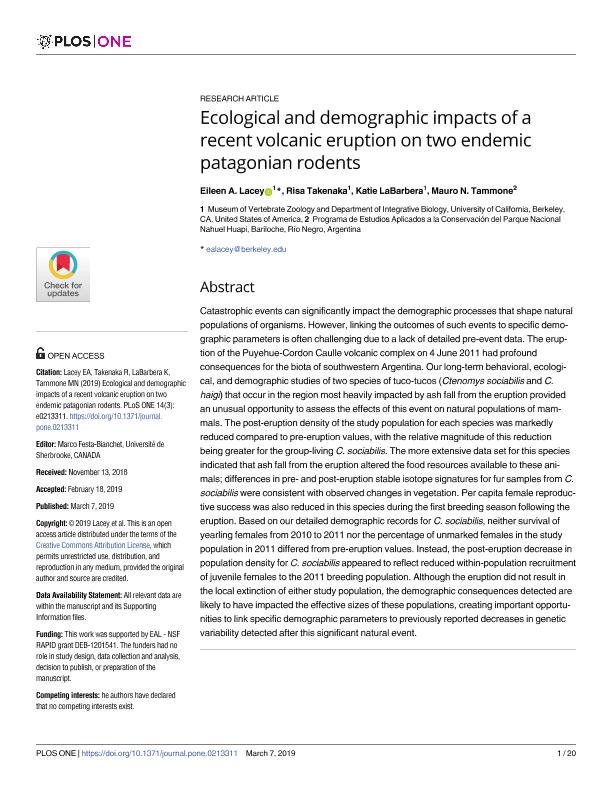Mostrar el registro sencillo del ítem
dc.contributor.author
Lacey, Eileen Anne

dc.contributor.author
Takenaka, Risa

dc.contributor.author
LaBarbera, Katie

dc.contributor.author
Tammone, Mauro Nicolás

dc.date.available
2021-01-11T15:47:02Z
dc.date.issued
2019-03
dc.identifier.citation
Lacey, Eileen Anne; Takenaka, Risa; LaBarbera, Katie; Tammone, Mauro Nicolás; Ecological and demographic impacts of a recent volcanic eruption on two endemic patagonian rodents; Public Library of Science; Plos One; 14; 3; 3-2019; 1-20; e0213311
dc.identifier.issn
1932-6203
dc.identifier.uri
http://hdl.handle.net/11336/122246
dc.description.abstract
Catastrophic events can significantly impact the demographic processes that shape natural populations of organisms. However, linking the outcomes of such events to specific demographic parameters is often challenging due to a lack of detailed pre-event data. The eruption of the Puyehue-Cordon Caulle volcanic complex on 4 June 2011 had profound consequences for the biota of southwestern Argentina. Our long-term behavioral, ecological, and demographic studies of two species of tuco-tucos (Ctenomys sociabilis and C. haigi) that occur in the region most heavily impacted by ash fall from the eruption provided an unusual opportunity to assess the effects of this event on natural populations of mammals. The post-eruption density of the study population for each species was markedly reduced compared to pre-eruption values, with the relative magnitude of this reduction being greater for the group-living C. sociabilis. The more extensive data set for this species indicated that ash fall from the eruption altered the food resources available to these animals; differences in pre- and post-eruption stable isotope signatures for fur samples from C. sociabilis were consistent with observed changes in vegetation. Per capita female reproductive success was also reduced in this species during the first breeding season following the eruption. Based on our detailed demographic records for C. sociabilis, neither survival of yearling females from 2010 to 2011 nor the percentage of unmarked females in the study population in 2011 differed from pre-eruption values. Instead, the post-eruption decrease in population density for C. sociabilis appeared to reflect reduced within-population recruitment of juvenile females to the 2011 breeding population. Although the eruption did not result in the local extinction of either study population, the demographic consequences detected are likely to have impacted the effective sizes of these populations, creating important opportunities to link specific demographic parameters to previously reported decreases in genetic variability detected after this significant natural event.
dc.format
application/pdf
dc.language.iso
eng
dc.publisher
Public Library of Science

dc.rights
info:eu-repo/semantics/openAccess
dc.rights.uri
https://creativecommons.org/licenses/by/2.5/ar/
dc.subject
Volcanic eruption
dc.subject
Ctenomys
dc.subject.classification
Ecología

dc.subject.classification
Ciencias Biológicas

dc.subject.classification
CIENCIAS NATURALES Y EXACTAS

dc.title
Ecological and demographic impacts of a recent volcanic eruption on two endemic patagonian rodents
dc.type
info:eu-repo/semantics/article
dc.type
info:ar-repo/semantics/artículo
dc.type
info:eu-repo/semantics/publishedVersion
dc.date.updated
2020-11-18T20:49:31Z
dc.journal.volume
14
dc.journal.number
3
dc.journal.pagination
1-20; e0213311
dc.journal.pais
Estados Unidos

dc.journal.ciudad
San Francisco
dc.description.fil
Fil: Lacey, Eileen Anne. University of California. Department of Integrative Biology. Museum of Vertebrate Zoology; Estados Unidos
dc.description.fil
Fil: Takenaka, Risa. University of California. Department of Integrative Biology. Museum of Vertebrate Zoology; Estados Unidos
dc.description.fil
Fil: LaBarbera, Katie. University of California. Department of Integrative Biology. Museum of Vertebrate Zoology; Estados Unidos
dc.description.fil
Fil: Tammone, Mauro Nicolás. Consejo Nacional de Investigaciones Científicas y Técnicas. Centro Científico Tecnológico Conicet - Patagonia Norte. Instituto de Investigaciones en Biodiversidad y Medioambiente. Universidad Nacional del Comahue. Centro Regional Universidad Bariloche. Instituto de Investigaciones en Biodiversidad y Medioambiente; Argentina. Ministerio de Ambiente y Desarrollo Sustentable. Administración de Parques Nacionales. Parque Nacional "Nahuel Huapi". Departamento Conservación y Educación Ambiental; Argentina
dc.journal.title
Plos One

dc.relation.alternativeid
info:eu-repo/semantics/altIdentifier/url/https://journals.plos.org/plosone/article?id=10.1371/journal.pone.0213311
dc.relation.alternativeid
info:eu-repo/semantics/altIdentifier/doi/http://dx.doi.org/10.1371/journal.pone.0213311
Archivos asociados
